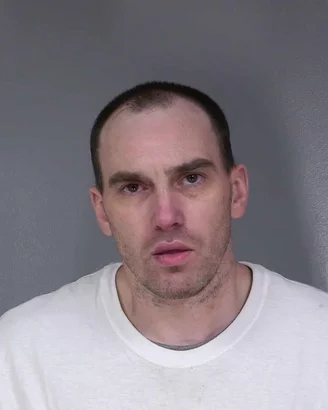Huge Drug/Gun Bust on Eureka’s McCullens Avenue, Says Drug Task Force
LoCO Staff / Monday, April 3, 2023 @ 3:36 p.m. / Crime
Photos: HCDTF.
Press release from the Humboldt County Drug Task Force:
On Thursday March 30, 2023 HCDTF served a search warrant at the 700 Block of McCullens Avenue in Eureka after receiving information that 38 year old Dustin Andrew Lawler was selling large amounts of fentanyl throughout Humboldt County.
During the service of the search warrant, agents determined Lawler was not on scene, but contacted and detained Lawler’s roommate 52 year old Nicholas March. During a search of the residence agents located 18.6 ounces of purple, green, and white fentanyl. They also located 310 muscle relaxer pills, 73 Soma pills, 106 capsules containing an unknown substance, 8 grams of methamphetamine, and six firearms. One of the firearms located was a .223 caliber AR style rifle with a nine inch barrel and was manufactured with no serial number (Ghost gun).
Subsequently, March was arrested on the following charges:
- H&S 11370.1(A)- Possession of controlled Substance while armed
- PC 30600(A)- Manufacture of an assault weapon
- PC 30605(A)- Possession of an assault weapon
- PC 33215- Possession of short barreled rifle
March initially lied to agents about his true identity and was arrested and booked under the false name. After booking, agents located his true identity and will be seeking additional charges of:
- PC 29800(A)(1)- Felon in possession of a firearm
- PC 30305(A)(1)- Felon in possession of ammunition
- PC 148.9(a)- Providing false identity to law enforcement
Additionally, agents have submitted a warrant declaration to the District Attorney’s Office for the following charges for Lawler:
- H&S 11351- Possession for sale of controlled substance
- H&S 11375(B)(1)- Possession of designated controlled substance
- PC 1203.2(A)- Violation of probation
BOOKED
Today: 10 felonies, 4 misdemeanors, 0 infractions
JUDGED
Humboldt County Superior Court Calendar: Today
CHP REPORTS
Us101 S / Humboldt Hill Rd Ofr (HM office): Traffic Hazard
5100 Centerville Rd (HM office): Traffic Hazard
7159 Sr36 (HM office): Trfc Collision-No Inj
0 CR315 (HM office): Trfc Collision-No Inj
ELSEWHERE
Governor’s Office: California delegation wraps historic participation at COP30: new global partnerships, clean energy records, and climate leadership
RHBB: Bonta Sounds Alarm: States Must Keep Power to Fight AI Threats, Attorneys General Tell Congress
County of Humboldt Meetings: Citizens’ Advisory Committee on Measure Z Expenditures Dec. 4 Meeting
KINS’s Talk Shop: Talkshop November 26th, 2025 – Steve Madrone
A Driver Carrying Pathology Specimens From St. Joe’s Patients Crashed in a Recent Winter Storm. The Samples Have Not Been Recovered.
Ryan Burns / Monday, April 3, 2023 @ 1:56 p.m. / Health Care
St. Joseph Hospital in Eureka. | Public domain.
###
On February 24, one of the most brutal days of winter weather in memory on the North Coast, a courier transporting pathology specimens from patients at Eureka’s Providence-St. Joseph Hospital lost control of his vehicle and drove off the side of the road.
With Hwy. 101 closed due to the weather, the courier had taken State Route 36, and according to one hospital employee, who asked to remain anonymous due to fear of professional repercussions, the driver’s vehicle went into a ravine and collided with a tree. The driver was hospitalized for a few days, the employee said.
The specimens, which included biopsied tissue from patients who may have cancer or other serious diseases, were lost in the crash and have not been recovered.
These tissue samples, which were contained within locking plastic cassettes, were being driven to a laboratory in Santa Rosa, where, if they had arrived, they would have been thinly sliced and placed onto microscope slides for diagnosis.
The Outpost first learned about the incident from a doctor who was formerly employed at the hospital. The doctor, who also asked to remain anonymous due to fear of retaliation, said surgeons at the hospital were told that their affected patients would need to be re-biopsied, likely delaying their diagnoses.
“It’s a fucking nightmare,” said the doctor, who we’ll refer to with the pseudonym Dr. Miller. “These poor patients who lost tissue on the side of the road will have to get a second procedure, if it’s even available.”
In some cases, the doctor explained, the biopsied tissue may have consisted of an entire tumor or other suspect material, meaning there’s now nothing left over to remove and test.
“If I was still there [working for the hospital], I’d be like, ‘We have to report this to the state,’” Dr. Miller said, adding that the biopsy cassettes likely contained personal patient information, potentially exposing Providence to violations of the Health Insurance Portability and Accountability Act (HIPAA), a federal law aimed at protecting sensitive patient health information.
In response to questions from the Outpost, Providence Northern California issued the following statement:
At Providence, the safety and integrity of our patient’s health information is among our highest priorities.
On February 24, a courier who contracts with Providence in Humboldt County was involved in a weather-related accident while transporting pathology specimens. Following the accident, we acted and informed affected patients via letter that their specimen may have been in the vehicle at the time of the accident.
A third-party retrieval company was brought in to assist in locating the specimens, and any related patient health information, but were not successful. We immediately sent follow-up letters informing patients and advised them to contact their provider to discuss next steps for their care.
We are deeply sorry for any interruption of care this accident may have caused our patients and their families. We look forward to continue providing high-quality, compassionate care for patients involved.
The hospital employee, who we’ll call Jennifer, said that until recently, these types of pathology samples never would have been sent to Santa Rosa; they would have been placed on microscope slides by employees in St. Joseph Hospital’s own histology department. But after being short-staffed for years months, the histology department was closed altogether last summer, Jennifer said.
The decision, she said, was made by upper management at Providence, a Catholic, not-for-profit health care system based in Renton, Wash., that merged with St. Joseph Health in 2016.
“It has led to terrible turnaround times,” Jennifer said of the histology department closure. “Surgeons are pissed off about it. … The patient has to wait longer to get results … [sometimes] by a couple of days.”
Last week, the Outpost asked a number of questions that were not answered in the statement issued by Providence. Among them:
- What exactly was lost (number of specimens)?
- What impacts has this incident had on patients?
- Did any patients have to be retested/re-biopsied?
- Have all affected patients been informed about the incident?
- Have state regulators been informed?
- When and why did Providence start sending pathology specimens to Santa Rosa for histology?
We sent a follow-up email this morning, repeating these questions to Communication Manager Christian Hill. We will update this post if and when he responds.
Explosive Devices and Bomb-Making Materials Found — Along With Drugs and Guns — at Bayside Residence, Sheriff’s Office Says; Two Arrested
LoCO Staff / Monday, April 3, 2023 @ 1:08 p.m. / Crime
Photos: HCSO.
Press release from the Humboldt County Sheriff’s Office:
On April 1, 2023, at about 12:40 p.m., Humboldt County Sheriff’s deputies were dispatched to the 200 block of Garden Lane in Bayside to investigate suspicious activity associated with a residence.
During their investigation, deputies learned that one individual associated with the residence, 42-year-old Ryan Michael Doucet, was on formal probation with a search clause. Deputies contacted Doucet, 30-year-old Kathleen Renee Ellis, and a young juvenile at the residence. During a search of the residence pursuant to the terms of Doucet’s probation, deputies located approximately 2 ounces of powdered fentanyl, over 15 grams of methamphetamine, drug paraphernalia and items consistent with the sale of controlled substances. These substances were found to be unsecured and accessible to the juvenile at the residence.
Deputies also located a box truck parked on the property associated with Doucet. Inside the truck, deputies located over 5.9 ounces of fentanyl, multiple firearms, ammunition, suppressors, body armor, bomb making materials and multiple improvised explosive devices. The Sheriff’s Explosive Ordnance Disposal Team responded and rendered the devices safe.
Doucet was arrested and booked into the Humboldt County Correctional Facility on charges of child endangerment (PC 273a(a)), possession of a controlled substance for sales (HS 11351), felon in possession of a firearm (PC 29800(a)(1)), person prohibited in possession of ammunition (PC 30305(a)), possession of an assault weapon (PC 30506), possession of a destructive device (PC 18710), manufacturing a destructive device without a permit (PC 18720) and possession of a firearm silencer (PC 33410).
Ellis was arrested and booked into the Humboldt County Correctional Facility on charges of child endangerment (PC 273a(a)) and possession of a controlled substance (HS 11350).
The juvenile was placed in safe custody.
Anyone with information about this case or related criminal activity is encouraged to call the Humboldt County Sheriff’s Office at (707) 445-7251 or the Sheriff’s Office Crime Tip line at (707) 268-2539.
California May Change Its Mental Health Funding. Why That Might Cut Some Services
Kristen Hwang / Monday, April 3, 2023 @ 7:39 a.m. / Sacramento
For the second time in as many years, Gov. Gavin Newsom is pushing for major reform of California’s mental health system, this time by overhauling the way counties spend mental health dollars and placing a bond measure before voters to build more psychiatric beds.
County behavioral health advocates and local service providers fear programs will be cut, and, much like the controversial CARE Courts legislation — which passed last year and allows individuals to petition a court to force seriously mentally ill people into treatment and housing — say Newsom’s initial announcement came as a shock.
“We listened to the press conference just like you,” said Christine Stoner-Mertz, executive director of the California Alliance of Child and Family Services, which represents organizations that provide child welfare, foster care, juvenile justice and youth behavioral health services.
The proposal is being pitched as a solution to the state’s ballooning homelessness crisis, but experts doubt it will make any kind of meaningful dent. No one has published bill language for the proposal, but Newsom unveiled two major changes during his March state-of-the-state tour:
- Divert 30% of existing Mental Health Services Act money toward housing people living on the streets who are severely mentally ill;
- Use a bond measure to generate between $3 billion and $5 billion for 6,000 residential psychiatric treatment beds.
Voters passed the Mental Health Services Act nearly two decades ago as a ballot initiative that levied a 1% tax on state millionaires to fund local mental health programs. Substantial changes to the act are subject to voter approval because it originally passed as a ballot measure in 2004.
The proposal aims to reprioritize a significant portion of the state’s existing behavioral health system to focus on what Newsom characterized as the state’s “most acute challenge,” which is the number of homeless people with mental illness and substance use disorders. Only about 20% of California’s approximately 172,000 homeless people have a severe mental illness, according to the U.S. Department of Housing and Urban Development, but the issue plays an outsized role in state politics.
“It’s unacceptable what we’re dealing with at scale now in the state of California,” Newsom said. “We have to address and come to grips with the reality of mental health in this state and our nation.”
Newsom, who made reducing homelessness a key part of his gubernatorial campaign in 2018, is contending with the reality of homelessness increasing by nearly 32% in the past four years. Though he has called out counties for not acting aggressively enough and dedicated nearly $10 billion to address the problem, he has also faced harsh bi-partisan criticism for what many view as a political stunt in threatening to withhold money from counties and failing to significantly increase the state’s housing stock.
“The question in our minds is what is the approach and process to solving some of these problems. We would welcome greater partnership around that.”
— Christine Stoner-Mertz, executive director of the California Alliance of Child and Family Services
Newsom’s proposal is backed by several lawmakers, including former Assemblymember and current Sacramento Mayor Darrell Steinberg, who co-authored the original act, and Sen. Susan Talamantes Eggman, a Democrat from Stockton who co-authored the CARE Court legislation and who has staked the remainder of her term on advancing mental health changes.
Those who do the on-the-ground mental health work in the state, however, say they have major concerns about such a large system shake-up. The focus on housing and the need for more behavioral health treatment beds is welcome, Stoner-Mertz said, but shouldn’t detract from the current workforce crisis and other problems exacerbated by the COVID-19 pandemic.
“One-third is a big chunk of money,” Stoner-Mertz said. “The question in our minds is what is the approach and process to solving some of these problems. We would welcome greater partnership around that.”
What the mental health funding proposal would change
On Wednesday, state officials revealed new details about the proposal. It changes the categories counties would be required to invest in, focusing most of the money on homeless adults. Counties would be required to spend 30%, or roughly $1 billion annually, of their Mental Health Services Act dollars on housing homeless people with serious mental illness or drug addiction. They would also direct 35% of the funds to full-service partnerships for these individuals, which include clinical treatment and social supports co-designed by the client and the program.
The remaining 35% could be used for a combination of existing programs like mental health prevention and early intervention, infrastructure and workforce investments, although officials made it clear that workforce would be a priority. Innovation grants that have historically been part of the program do not have any dedicated funds. The proposal also opens the door to using the money for people who struggle with addiction but don’t have additional mental health needs.
In contrast, current regulations give counties broad flexibility in using the money. A minimum of 38% must be spent on full-service partnerships, although counties can spend up to 70% on these services. (Full-service partnerships are intensive wraparound services designed to do “whatever it takes” to meet the client’s long-term needs. They can include things like 24/7 case management, clinical treatment, and housing.) About 19% is reserved for prevention and early intervention programs, much of which focuses on children, and 5% for innovation. Some counties choose to use a portion of the funds for workforce and infrastructure needs.
There are some concerns about whether counties have historically met minimum spending requirements, particularly for full-service partnerships, but there’s no question that the money has become an integral part of the state’s behavioral health system, making up nearly one-third of all spending. Last year the tax generated about $3.8 billion. Newsom’s proposal introduces standardized accountability measures and reduces the amount of money counties are allowed to keep in reserves.
In addition, language will be placed on the 2024 ballot asking for a general obligation bond to pay for 6,000 psychiatric and substance abuse treatment beds. These beds would serve approximately 10,000 people annually, according to a fact sheet from Newsom’s office, by providing long-term residential treatment. An undetermined portion of the bond funds would be used to house homeless veterans.
For many mental health organizations, the bond to increase residential care capacity is much easier to swallow than prescriptive changes to how mental health dollars are spent. The state faces a shortage of more than 7,700 adult psychiatric beds, according to a 2021 RAND report commissioned by the County Behavioral Health Directors Association.
“We really appreciate the administration looking at the report that we did, and the focus on building out infrastructure is wonderful,” said Michelle Doty Cabrera, executive director of the County Behavioral Health Directors Association. “But we continue to need the same kind of focus on workforce and funding for services ongoing.”
At the same time that Newsom is advancing this proposal, his January budget delays $1.1 billion in other behavioral health investments over the next two years, including money intended to increase treatment capacity for adults and kids in crisis, and money for workforce development.
What are the primary concerns?
There’s no telling how exactly existing mental health priorities will get reallocated, but cuts are nearly inevitable given how heavily counties rely on the dollars. The money is “braided into the fabric of all things in our safety net,” Doty Cabrera said.
But some of the most pressing questions come from those who work with children and families. Currently, at least half of the money earmarked for prevention and early intervention must be used for children and young adults.
“This is the only protection from our perspective that is actually going to keep a focus on young people and keep a focus on more upstream services,” said Adrienne Shilton, director of public policy for the nonprofit California Alliance of Child and Family Services.
That money is potentially on the chopping block under the new proposal, as are innovation grants that have catalyzed multi-county programs to improve services for communities of color and LGBTQ folks.
Historically, Medi-Cal — the state’s public health insurance program for extremely low-income residents — has not covered behavioral health prevention programs, which is where the Mental Health Services Act becomes important. The money was intended to allow counties the greatest amount of flexibility in meeting local needs, particularly when other funding streams came with restrictions, said Toby Ewing, executive director of the Mental Health Services Oversight and Accountability Commission.
“It is designed to be a counterpoint to historic restrictions that were in place for Medi-Cal,” Ewing said.
The public perception that California’s homelessness crisis is caused by psychiatric emergencies and drug addiction is a false one.
At the same time that the money gives counties the ability to provide services beyond Medi-Cal, they also use qualifying program expenses to draw down matching Medi-Cal federal funds, effectively expanding local mental health programs. Collectively, counties use about half of the money on services that qualify for matching federal dollars, Doty Cabrera said.
With about $1 billion earmarked for housing, which the federal government will not pay for, the mental health system may face between $500 million and $1 billion in lost federal revenue, Shilton said, if Newsom’s proposal is approved.
Dr. Mark Ghaly, state secretary for Health and Human Services, disagrees with the assumption that these changes mean cuts will happen. The administration’s team has heard the same concerns in stakeholder meetings following the announcement and will work with counties “to try to maintain as much as we possibly can with them,” Ghaly said.
“There is no reason why we won’t be able to do a lot on the prevention and early intervention side,” Ghaly said.
He also notes that this proposal can’t be considered alone. It is part of a larger strategy to improve mental health services in the state, which includes sweeping changes to Medi-Cal, a children’s behavioral health initiative and investments in crisis response. One piece of the puzzle seeks permission from the federal government to use Medi-Cal dollars on housing, which would allow counties to still draw down a significant portion of matching funds.
“All of these things come together, build on each other, and I would like to say catalyze one another to promote the transformation,” Ghaly said. “This is, in my mind, government doing well.”
Will this help homelessness? Not really.
The proposal has been couched as a solution to California’s explosive homelessness problem, which consistently tops the list of voter issues.
“We’re fooling ourselves that if we don’t address that fundamental need that we can turn this thing around,” Newsom said during his press conference, backed by more than a half dozen officials who detailed homeless issues from state, county, city and personal perspectives.
But the public perception that California’s homelessness crisis is caused by psychiatric emergencies and drug addiction is a false one. Rather, decades of politicians upholding restrictive zoning laws and obstructive environmental policies have pushed California to the bottom of affordable housing rankings and are the primary drivers of homelessness in the state. Other factors, like changes to the state’s criminal justice system, also contribute. Dr. Margot Kushel, director of the UC San Francisco Benioff Homelessness and Housing Initiative, said no amount of spending on mental health will improve the state’s overall homelessness problem.
Still, she and other medical professionals who work primarily with unhoused people say the most vulnerable people on the streets are those with untreated mental illness, and prioritizing housing is the most important thing the state can do for that population’s physical and mental health. People living without shelter also face dismal health outcomes, and discharging a patient back to the street is a recipe for swift deterioration.
Even local and county behavioral health groups that have raised concerns about the proposal acknowledge the need for more housing for their clients, but they fear an inversion of the current problem — housing without services — will result.
“My concern is robbing Peter to pay Paul,” said Debbie Manners, president and CEO of Sycamores, a Los Angeles behavioral health and child welfare agency. Sycamores serves about 500 children and families daily through its school-based mental health program. Two years ago the state allocated $4.4 billion to a Children and Youth Behavioral Health Initiative, but it’s a one-time investment.
“I’m not sure how that will fill in the gap. I don’t think it will fill the gap,” Manners said.
Unfortunately, limited funding is the reality of this year’s budget cycle, with the Legislative Analyst’s Office projecting a $24 billion deficit.
“You don’t want to pit one need for money against another, and I get that,” Kushel said. “On the other hand, it isn’t really possible to serve this population without their having housing.”
###
CalMatters.org is a nonprofit, nonpartisan media venture explaining California policies and politics.
OBITUARY: Lorna Jane Petersen, 1934-2023
LoCO Staff / Monday, April 3, 2023 @ 7:26 a.m. / Obits
Lorna Jane Petersen of Eureka passed away peacefully on March 2, 2023 due to complications from Alzheimer’s Disease. She was 88 years old. Lorna was born to Hilmer and Elvina Pederson in Arlington, South Dakota on April 17, 1934. The oldest of five siblings, she grew up playing sports and spending time with her friends and siblings, including her sister and best friend, Bonnie. In sixth grade, Lorna was asked to play on the girls softball team, eventually becoming pitcher while Bonnie played catcher. Lorna and Bonnie also played basketball together, Lorna as a forward, Bonnie as a guard. As a teenager, she won first place in a foot race down main street in Arlington during their hometown celebration.
Lorna married the love of her life, Dennis Petersen, in 1954 in Arlington, South Dakota following his return from serving in the U.S Army during the Korean War from 1952-1953. They were briefly stationed in Tacoma, Washington where they had their first son, Michael, then returned to South Dakota where they took over the running of Dennis’ family’s farm. There, they had 2 more children, Monica and Mitchell. Dennis loved the coast, and in 1962, the family relocated to Humboldt County, California, eventually settling in Eureka. Lorna worked in a number of positions, including as the manager of the Yardage Department at JC Penney, in the cafeteria at Zane Junior High School and at Pat’s Market for a number of years while Dennis ran his own backhoe service. Dennis and Lorna brought their love of farming to the coast, their backyard was always beautifully maintained and they had fruits and vegetables growing year-round. They had a tent trailer and went camping regularly, often at Fish Lake in Orleans and Swimmer’s Delight near Carlotta. Lorna was a fantastic cook and made the most wonderful meals on holidays or special occasions, including her tradition of making Pizza Burgers on Christmas day, a celebration that the family adored and looked forward to every year. Anytime the family was together, Lorna would have everyone stop and gather around so she could take pictures. She enjoyed knitting and sewing and always made blankets for the children in the family. Lorna was a breast cancer survivor who walked in the American Cancer Society’s Relay for Life with her daughter, Monica, who was also a cancer survivor.
Following their retirement, Dennis and Lorna bought a lovely log cabin on a ¼ acre lot that had a beautiful view of Campbell Ridge in Willow Creek and sat just above the Trinity River. They continued their love of gardening and grew fruits and vegetables which they enjoyed sharing with friends and family. They enjoyed going on drives to explore the Willow Creek area and learn about the local history. She stayed in close contact with her siblings and was incredibly proud of her children who she always remained in close contact with. She and Dennis also loved to dote on their grandchildren and regularly attended their sporting events and school performances.
In 2012, Dennis’ health began to decline and they moved back to Eureka to be closer to family. They purchased a beautiful home in Cutten set in a redwood grove where they could watch deer and other wildlife from their living room window. Sadly, Dennis passed away in 2014, but Lorna continued living in the home with family visiting frequently. Dennis and Lorna’s grandson, Josiah, attended school nearby, and every Friday, they would walk to her house together. Josiah had always loved his Great Grandparents and he and Lorna became best buddies during their time together, always teasing and joking with each other. Eventually, however, Lorna was diagnosed with Alzheimer’s Disease and required additional care, so moved into an assisted living facility where she continued to have loved ones visit regularly while receiving wonderful care.
Lorna was preceded in death by her husband of 59 years, Dennis Petersen, her parents, Hilmer and Elvina Pederson, and her siblings LeRoy Pederson and Geraldine Wiederman. Her granddaughter, Heather Petersen, passed away two weeks after Lorna from breast cancer.
She is survived by her three children, Michael Petersen (Melinda) of Eureka, Monica Caetano (Frank) of Bayside and Mitchell Petersen (Debra) of Corning, Calif. She is also survived by her two siblings, Bonnie Mullet of Goshen, Indiana and Loren Pederson of The Dalles, Oregon. She is also survived by her five Grandchildren, Crystal Hisaw, Nicole Petersen-Log, Michelle Petersen, T.J. Wilson, and Shelby Wilson, as well as six great-grandchildren: Josiah, Daphne, Killian, River, Kianna and Farrah.
The family wishes to thank Lorna’s in-home care provider, Deana Gurney, the exceptional staff atEspecially You Assisted Living and the wonderful folks at Hospice of Humboldt for their kindness and continuous care in her later years. Per Lorna’s request, no celebration of life will be held, but please feel free to share your memories of her at www.lostcoastoutpost.com.
###
The obituary above was submitted on behalf of Lorna Petersen’s loved ones. The Lost Coast Outpost runs obituaries of Humboldt County residents at no charge. See guidelines here. Email news@lostcoastoutpost.com.
GROWING OLD UNGRACEFULLY: Marion Rube’s Checkered Life
Barry Evans / Sunday, April 2, 2023 @ 7 a.m. / Growing Old Ungracefully
On Tuesday December
18, 1928, two armed men disrupted the morning routine of the First
National Bank of Coquille, 20 miles upstream from Bandon, Oregon.
When they failed to gain access — the Vice-President of the bank
slammed the door in their faces — they drove off in a stolen car.
At the edge of town, they abandoned the vehicle and took to the
woods, chased by several townspeople who had been alerted by the
bank’s alarm. A local furniture dealer took aim at one of the
would-be robbers, bringing him down with one shot. Thus ended the
criminal career, and life, of Marion Rube. He was 33.
The scene of Marion Rube’s unsuccessful robbery on the day he died. Coquille’s First National Bank building, built in 1910, was demolished last year. (Unknown photographer)
Rube was a Klamath Native American from the Hoopa Reservation, as was his half-brother, Harrison Smith, a man who served time in San Quentin after a stabbing incident at Martin’s Ferry. After being released, Smith illegally brought whiskey onto the reservation. When confronted by Oscar McCardie, a Hoopa policeman, he was drunk and resisted arrest, and the encounter ended with the policeman shooting Smith dead. That was in February 1915.
Although Smith’s death was ruled justifiable, Indian law demanded that his family be compensated. They refused the $250 offered by McCardie who, from then on, lived in fear for his life, eventually quitting his job and turning to ranching. Six years later, in May 1921, he was shot and killed by Marion Rube, avenging the death of his half-brother as demanded by family honor. Rube was no stranger to firearms; he’d been a sharpshooter in France during World War One. After two trials, both of which ended in a hung jury, Rube was acquitted. Now it was Rube’s turn to compensate McCardie’s family, in accordance with tribal law.
Lacking the necessary funds, Rube determined that banks represented his best hope because, as bank robber Willie Sutton would later explain, “That’s where the money is.” (Apocryphally — a reporter interviewing Sutton in prison actually came up with the phrase.) For his first target, Rube picked the Bank of Fortuna, now the Harland Law Firm on Main Street. It was an unfortunate choice. In a sequence worthy of the Mack Sennett’s Keystone Cops, he and his prizefighter accomplice did indeed rob the bank, but they failed to get away cleanly. They got as far as Carlotta, with a posse of cars in hot pursuit (is there any other type of pursuit?). There, the Oldsmobile which they’d stolen four days earlier quit on them, its wheel bearings burned out after a high-speed chase.
Both men were subsequently captured, Rube meanwhile having stashed his share of the take, $16,000, “at three different locations on the mountain within a half mile of downtown Pepperwood.” according to his then-wife Alice, interviewed in 1988 at age 92. According to one story, the money was never found; another version has Alice driving an expensive new car (a Stutz-Bearcat, for aficionados) soon after the robbery.
In a nod to history, the entrance of the National Bank of Coquille remains as a token shrine to old building. (Barry Evans)
After spending seven years in San Quentin, Rube escaped, three times in the same week, the third time successfully. The story only gets weirder from here. After two months on the lam, Rube shot dead a rancher that he’d mistaken for one of the deputies looking for him. Two months later, he and a partner made their unsuccessful attempt to rob the National Bank of Coquille: see above. According to Jerry Rohde, who records the saga in detail in his book Both Sides of the Bluff, Marion Rube promised he’d never be taken alive. He got his wish.
HUMBOLDT TEA TIME: Eureka Books Owner Solomon Everta on His Weird History and His Vision for the Future of the Shop, and the World
LoCO Staff / Saturday, April 1, 2023 @ 3 p.m. / People of Humboldt
If you’re a bookish type, you know Solomon Everta. As of today he’s owned Eureka Books for exactly one year — happy anniversary! — and he was stationed behind the counter at the historic “J-Lo Building” for several years before that, dispensing recommendations and helping you find what you were looking for, even if you didn’t know quite what you were looking for yourself.
Everta is an excellent guest for the second episode of Humboldt Tea Time, in which the Outpost’s resident tea aficionado, John Kennedy O’Connor, gets to know a member of the community. This week, O’Connor was pleased to suffer through his guest’s ghastly herbal concoction because that guest was such an interesting guy.
Topics discussed: Everta’s early experiences volunteering for Food Not Bombs. Much later, his stint working for the County Clerk-Recorder’s Office. How both those experiences inform his work today, not only as a bookseller but as an author of “fabulist” history about his adopted hometown, which he loves very much.
His egalitarian vision of the shop goes far beyond moving merchandise. “Eureka Books is a place people can find their stories,” Everta says, “then use stories that have been told in the past to build the story of the future.”
Brew up a pot of your own — ginger-lemon, if you must — and tune in via the video player above. Then, join the anniversary celebration at Eureka Books during Arts Alive! tonight. There will be cake.










